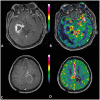Cerebral blood volume calculated by dynamic susceptibility contrast-enhanced perfusion MR imaging: preliminary correlation study with glioblastoma genetic profiles
- PMID: 23977117
- PMCID: PMC3747204
- DOI: 10.1371/journal.pone.0071704
Cerebral blood volume calculated by dynamic susceptibility contrast-enhanced perfusion MR imaging: preliminary correlation study with glioblastoma genetic profiles
Abstract
Purpose: To evaluate the usefulness of dynamic susceptibility contrast (DSC) enhanced perfusion MR imaging in predicting major genetic alterations in glioblastomas.
Materials and methods: Twenty-five patients (M:F = 13∶12, mean age: 52.1±15.2 years) with pathologically proven glioblastoma who underwent DSC MR imaging before surgery were included. On DSC MR imaging, the normalized relative tumor blood volume (nTBV) of the enhancing solid portion of each tumor was calculated by using dedicated software (Nordic TumorEX, NordicNeuroLab, Bergen, Norway) that enabled semi-automatic segmentation for each tumor. Five major glioblastoma genetic alterations (epidermal growth factor receptor (EGFR), phosphatase and tensin homologue (PTEN), Ki-67, O6-methylguanine-DNA methyltransferase (MGMT) and p53) were confirmed by immunohistochemistry and analyzed for correlation with the nTBV of each tumor. Statistical analysis was performed using the unpaired Student t test, ROC (receiver operating characteristic) curve analysis and Pearson correlation analysis.
Results: The nTBVs of the MGMT methylation-negative group (mean 9.5±7.5) were significantly higher than those of the MGMT methylation-positive group (mean 5.4±1.8) (p = .046). In the analysis of EGFR expression-positive group, the nTBVs of the subgroup with loss of PTEN gene expression (mean: 10.3±8.1) were also significantly higher than those of the subgroup without loss of PTEN gene expression (mean: 5.6±2.3) (p = .046). Ki-67 labeling index indicated significant positive correlation with the nTBV of the tumor (p = .01).
Conclusion: We found that glioblastomas with aggressive genetic alterations tended to have a high nTBV in the present study. Thus, we believe that DSC-enhanced perfusion MR imaging could be helpful in predicting genetic alterations that are crucial in predicting the prognosis of and selecting tailored treatment for glioblastoma patients.
Conflict of interest statement
Figures








References
-
- Mellinghoff IK, Wang MY, Vivanco I, Haas-Kogan DA, Zhu S, et al. (2005) Molecular determinants of the response of glioblastomas to EGFR kinase inhibitors. N Engl J Med 353: 2012–2024. - PubMed
Publication types
MeSH terms
Substances
LinkOut - more resources
Full Text Sources
Other Literature Sources
Medical
Research Materials
Miscellaneous

